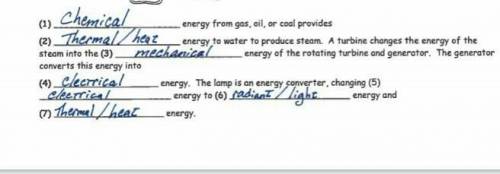 22
22  22
22  7
7  7
7  2
2 I hope its help for you
have a great day

 6
6 1. chemical energy --> electrical energy --> light energy
2. Electrical Energy --> Mechanical Energy
3. Electrical Energy --> Heat Energy
4. Chemical Energy --> Thermal Energy --> Mechanical Energy
5. Nuclear Energy --> Light energy and thermal energy
6. Mechanical Energy --> Electric Energy
7. Chemical Energy --> Electrical Energy --> Sound Energy
8. Mechanical Energy --> Sound Energy
Explanation:
 2
2 I hope its help for you
have a great day

 5
5  5
5  54
54 Controlled experiment is an experiment which is designed to test a variable, which can be changed during the experiment.
Explanation:Hence in this experiment, the importance of experiment is being tested, as it is added only in one set of plant.
A manipulated variable is an independent variable whose amount can be changed during an experiment.
Here the fertilizer is a manipulated variable.
Question 2:Because theory is the most organised statement proved by a set of independent experiments.
Explanation:Hypothesis is the initial idea on which basis different experiments are conducted. But if 1 experiment succeeded and it supports the hypothesis, hypothesis do not become a theory.
For a theory, different experiments are necessary which supports that hypothesis.
Question no 4.Density = 1.909 kg/m3
Explanation:Given data:
Mass of the object = 42 kg
Volume of the object = 22 m3
Density of the object = ?
Solution
Density = mass/volume
Density =42/22 = 1.909
Density = 1.909 kg/m3
Hence the density of the object is 1.909 and its unit is kg/m3 which is system international unit of density.
Question 5.Chlorine and water in swimming pool are mixed in such a way that there composition remains same throughout the mixture. And chlorine cannot be separated back from water. This is the homogeneous mixture.
Explanation: A homogeneous mixture is a mixture of more than one substance which are mixed together in such a way that they cannot be separated and the composition of the mixture remains same throughout the mixture. Example of homogeneous solution is sugar solution in water. As for swimming pool cleaning chlorine is added in pool water, it mixes in the whole water by diffusion. Hence it is a homogeneous mixture. Question no. 6.Because physical change does not include composition change, it includes change in physical parameters. And in splicing tomato only change in shape is done.
Explanation: Chemical change means irreversible chemical composition change like the burning of toast. Physical change means reversible or irreversible change in shape, volume density without change in chemical composition. Splicing tomato comes under 2nd category because it does not include chemical change.Remaining questions are attached in the files.

It will provide an instant answer!
